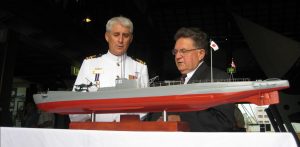- Author
- A.N. Other
- Subjects
- History - general, Ship histories and stories
- Tags
-
- RAN Ships
- None noted.
- Publication
- September 2011 edition of the Naval Historical Review (all rights reserved)
Australia is well blessed by a number of small maritime museums but as these are on our doorsteps they are often overlooked. We have asked the curators of a number of these to provide an update of their importance. This is the first article in this series.
By Richard Howard – Manager Newcastle Maritime Centre
On 10 May 1770, Captain James Cook, sailing along the east coast of Australia on board the HMB Endeavour sighted a ‘small clump of an island’. That island is now one of Newcastle’s most famous landmarks, Nobby’s Headland. From that time onwards the growth of Newcastle depended on its links with the sea.
Following the discovery of gold in California in 1849 and the cancellation of the Australian Agricultural Company’s coal monopoly, sailing ships flocked to Newcastle for coal. The fledgling city became a major link in the sailing ships tramp around the world. Windjammers carried coal, wheat, nitrates and other cargo from Newcastle to points across the globe.
Power was near by the end of the sail era and steam had arrived to stay. The famous packet steamers, the finest in Australia, provided undreamt of comfort on the oldest coastal steamer service in the colonies, as they voyaged between Sydney, Newcastle and Morpeth. Their intensive rivalry and accidents were all part of the early development of the Hunter Region.
Newcastle Harbour has an entrance flanked by reefs and shallows, with a lee shore beckoning the unwary. Vessels were lost with all hands barely a stone’s throw from calm water. They were caught in gales, and scattered, sunk, or driven ashore, their crews suffering great hardship. Two vessels still stand as a warning for the unwary. The Adolphe, now lying next to the northern breakwater met her demise in 1904, and Stockton Beach retained its fearsome reputation by refusing to surrender the Sygna to salvagers in 1974. More recently in 2007 the 77,000 ton Pasha Bulker provided a very visual reminder of the risk to unwary seamen.
The entrance to the port of Newcastle is also famous for housing one of the few gun installations in eastern Australia that had an opportunity to fire at the Japanese during World War II. In the museum’s soon to be opened Forgotten War exhibit the story of the Australian Merchant Navy and the Japanese submarines that caused so many maritime deaths will be told. A key part of the exhibit will be a 1.5m model of the I-21, the submarine which not only attacked and sank vessels like the Iron Knight (also featured in the exhibition) but was also responsible for the shelling of Newcastle itself on 8 June 1942.

I-21 was one of the largest and most modern submarines in the world at that time. The I-class boats were up to 2900 tons and carried up to 120 crew. Along with other enemy submarines, I-21, which even carried a spotter plane, had been lurking in the waters off eastern Australia and New Zealand for more than two weeks. It was part of a group of six submarines called the Eastern Attack Group formed to disrupt shipping in the South Pacific. Part of the group left Truk, in the Caroline Islands, on May 18. At around 2 am on 8 June the
Captain moved I-21 into position off Newcastle Bight, about 7000 yards north-east of the entrance to the harbour, and prepared to commence the shelling.
Many of the shells were said to be old (WWI surplus from England, exposed to the elements for large periods of time) and failed to explode. Indeed it was reported that one shell landed at the front of a factory in Mayfield and the night watchman had time to ring his supervisor and ask what steps he should take now. His supervisor advised him: ‘Bloody great big ones… backwards!’ Suddenly the war had literally come right to our doorstep and the wartime experience of Novocastrians would never be the same again.
After more than two centuries of operation, the Port of Newcastle remains a globally-recognised hub and its people are leaders in the maritime industry. Since 1972, the Newcastle Maritime Museum has compiled an interesting and eclectic collection of artefacts, photos, documents and books relating to the maritime heritage of the Hunter Valley. This collection contains some 30,000 photographs and 5,000 archival items and artefacts.




